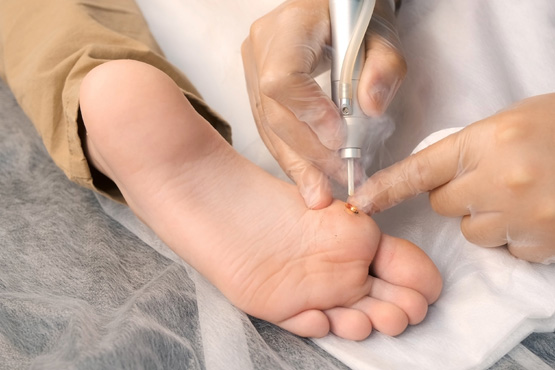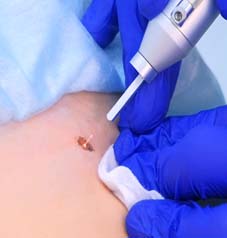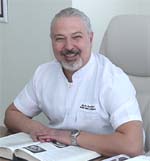WART TREATMENT

What is a wart?
Warts are benign (non-cancerous) and hyperkeratotic (excessive keratin accumulation) lesions that are caused by a human papillomavirus (HPV) infection and are usually located in the upper layer of the skin. These lesions can exhibit different structural features depending on various types of HPV and can appear on various parts of the body. The most common places they are seen include fingers and toes, the genital area, and sometimes the face.
What are the types of warts?
The variable types of HPV determine the different appearances and locations of warts. For example, HPV types 1, 2, and 4 generally cause common warts on the hands and feet, which are usually hard, raised, and cauliflower-like. In contrast, HPV types 6 and 11 generally lead to genital warts, which are softer, flat, and typically cauliflower-like in appearance.
We can examine the types of warts under different headings. These are,
What are the symptoms of warts?
The clinical symptoms and signs of warts vary depending on their locations and sizes. For example, plantar warts (warts seen on the soles of the feet) can cause pain during walking or running because the full weight of the body presses on these areas. In addition, genital warts can cause both cosmetic and sexual health issues. These include aesthetic concerns, the risk of sexual transmission, and rarely, a predisposition to certain types of cancer (e.g., cervical cancer) depending on the HPV types.
Why is wart treatment necessary?
Although warts are generally benign lesions, treatment is usually required for the following reasons:
How is wart treatment performed?
The main goal of wart treatment is to completely destroy the wart and the blood vessels feeding it. During the treatment process, the destroyed tissue is expected to be replaced by healthy tissue. The important point here is to effectively destroy the wart tissue while inflicting minimal damage to the healthy tissue next to the lesion.
There are different treatment options for wart treatment. Let's examine these methods one by one.
Laser Wart Treatment
Laser treatment is one of the most effective methods used in the treatment of genital warts. This method uses laser technology, which can focus very precisely on the target tissue, ensuring the treatment is more precise on the correct wart. The precise focusing ability of lasers prevents damage to healthy tissue and speeds up the healing process. Laser treatment is generally performed under local anesthesia and is typically less painful than other methods. The recovery time with this method is usually shorter compared to other treatments, and patients can typically return to their normal activities within a few days. Additionally, laser treatment is a method where recurrence of warts is less likely. The laser also coagulates (clots) blood vessels, ensuring minimal bleeding during and after the operation. Laser treatment is particularly effective in treating large warts or warts in hard-to-reach areas of the body, like the rectum.
Wart Treatment with Radiofrequency
The radiofrequency method works by converting electrical current into radiofrequency waves and producing thermal energy in a specific target tissue. This thermal energy heats the cells of the tissue, leading to denaturation of proteins (i.e., alteration of their structure and loss of function) and cell death. Radiofrequency is a method with less risk of lateral tissue damage, less risk of leaving a scar, and less postoperative pain risk compared to electrosurgery and cryotherapy.
Wart Treatment with Cryotherapy
Cryotherapy is a medical treatment method that works by freezing the target tissue. Liquid nitrogen gas is commonly used, and it is generally used to treat conditions such as skin lesions, warts, and some skin cancers. The freezing process leads to the rupture of the cell membrane and cell death. However, cryotherapy can be painful during the procedure and may not be suitable for treating multiple warts in the anus and genital area.
Wart Treatment with Electrosurgery
Electrosurgery is a wart treatment method that uses electrical energy. Electrosurgery burns off warts on the skin. However, warts burned off with electrosurgery can leave a burn mark or cause changes in skin color. Also, the treatment process and post-treatment can be painful.
Surgical Treatment
Sometimes, warts may have spread over a wide area or become tumorous. In these cases, it may be necessary to surgically remove the warts. Surgical intervention is generally performed under local or general anesthesia.
Wart Medications
There are various medications used in the treatment of genital warts. Some medications are immunomodulators and antiviral agents that trigger the immune system, and others work by dissolving the wart and causing destruction.
How to Treat Warts at Home?
Home wart treatment can generally be done using over-the-counter products and some natural methods. Home methods are generally suitable for mild cases. Below you can find some home wart treatment methods:
In conclusion, even if home wart treatment is to be applied, it is not correct to start such treatments without referring to a specialist doctor's recommendation.
Wart Treatment Prices
Wart treatment prices can vary depending on various factors. These factors include the number of warts, how widespread they are, their location, and the type of anesthesia method used during treatment. Whether an HPV Test, HPV Vaccine, and Smear Test were performed during the treatment process can also affect the price.
Due to Ministry of Health rules, we cannot share information about HPV test, smear test, HPV vaccine, and wart treatment prices on our site. Our prices are not secret. If you provide us information about your warts or send a photo of your warts to the phone number 0 850 490 14 78, you can get detailed information about wart treatment prices before coming to our clinic.
In our Wart Treatment Center in Silivri, we have methods such as electrosurgery, cryotherapy, and radiofrequency, but we mostly prefer fractional lasers. We prefer lasers due to their high success rate, less scarring, fewer color changes, and lower recurrence rate.
For more information about wart treatment, wart laser, HPV test, HPV vaccine, Smear, and colposcopy procedures, or to make an appointment, you can call our numbers 0505 260 72 38 and 0 850 490 14 78.
This article may also interest you

Wart removal is a medical procedure used to treat warts. Warts are benign lesions that occur in the upper layer of the skin, mostly caused by the HPV.
Read more

 TR
TR EN
EN